Search
- Page Path
-
- HOME
- Search
- Original Article
- Association between macrophage migration inhibitory factor gene and growth differentiation factor 15 gene polymorphisms and circulating levels with respiratory distress syndrome among preterm neonates
- Ali Helmi Bakri, Mohammed H. Hassan, Khaled Abdalla Abd-Elbaseer, Mahmoud Abo -Alhassan Sayed, Ahmed Alamir Mahmoud Abdallah, Eman Ahmed Abd-Elmawgood
-
Background: In preterm newborns, neonatal respiratory distress syndrome (RDS) is among the main causes of respiratory failure and mortality. However, the effect of macrophage migration inhibitory factor (MIF) on neonatal developmental lung disease is not well documented in the literature. Moreover, little is known about the effects of growth differentiation factor-15 (GDF-15) on lung maturity in preterm infants.
Purpose: To evaluate... -
DOI: https://doi.org/10.3345/cep.2025.00416 [Accepted]
- Review Article
- Impact of hematopoietic stem cell transplantation on growth outcomes in mucopolysaccharidosis: a systematic review
- Farzaneh Abbasi, Asal Khalili Dehkordi, Reihaneh Mohsenipour
-
Mucopolysaccharidosis (MPS) is a group of genetic disorders characterized by defective lysosomal enzyme activity that can result in growth abnormalities and other complications. Hematopoietic stem cell transplantation (HSCT), especially bone marrow transplantation (BMT), aims to restore enzyme function and improve growth parameters in patients with MPS. This systematic review evaluates the impact of HSCT on growth outcomes, including height, weight,... -
DOI: https://doi.org/10.3345/cep.2024.01725 [Accepted]
- Nutrition
- The Korea Infant Physical Growth Examination Survey (KIPGroS): a study protocol
- Jong Woo Hahn, MinSoo Shin, Jin Gyu Lim, Yoon-Joo Kim, Ki Soo Kang, Narae Lee, Seong Hee Jeong, Mun Hui Jeong, Yeoun Joo Lee, Eui Kyung Choi, Jung Ok Shim, Jee Yoon Park, Chan-Wook Park, Joo Young Kim, Su Jin Jeong, Young Hwa Jung, Jaehyun Kim, Chang Won Choi, Ju Whi Kim, Seung Han Shin, Yun Jeong Lee, Young Ah Lee, Choong-Ho Shin, Seung-sik Hwang, Young Eun Kim, Youn Ha Kang, Kyungwon Oh, Sungha Yun, Jae Sung Ko, Jin Soo Moon
- Clin Exp Pediatr. 2025;68(5):352-358. Published online February 13, 2025
-
The suitability of World Health Organization (WHO) growth charts for assessing the growth of children under 3 years of age in all countries remains controversial, and their applicability must be evaluated based on country-specific growth data. The Korea Infant Physical Growth Examination Survey evaluated the suitability of WHO growth charts to contribute to the next revision of growth charts in Korea.
- Neonatology (Perinatology)
- Recent advances in understanding pathophysiology of non-nutritional stunting in very preterm infants
- Eduardo Cuestas, Alina Rizzotti
- Clin Exp Pediatr. 2025;68(4):287-297. Published online December 23, 2024
-

· Previous reviews of extrauterine growth restriction focused mainly on weight growth restriction caused by nutritional factors or pathological conditions.
· This review summarizes recent developments in the pathophysiology of nonnutritional length growth restriction in very preterm infants with focus on the impact of sustained neonatal inflammation on their short- and long-term outcomes.
· Further research is needed to investigate optimal strategies to improve length growth restriction in very preterm infants.
- Endocrinology
- Growth plate closure and therapeutic interventions
- Ja Hyang Cho, Hae Woon Jung, Kye Shik Shim
- Clin Exp Pediatr. 2024;67(11):553-559. Published online October 28, 2024
-

Height gains result from longitudinal bone growth. Upon adequate growth, growth plate closure limits longitudinal bone growth. To date, gonadotropin-releasing hormone analogs, aromatase inhibitors, C-type natriuretic peptide analogs, and fibroblast growth factor receptor 3 inhibitors have been studied or used as therapeutic interventions to delay growth plate closure and increase human height. The development of more effective therapeutic modalities for short stature, precocious puberty, and skeletal dysplasia is anticipated.
- Neonatology (Perinatology)
- Retinopathy of prematurity: a review of epidemiology and current treatment strategies
- Eun Hee Hong, Yong Un Shin, Heeyoon Cho
- Clin Exp Pediatr. 2022;65(3):115-126. Published online October 12, 2021
-
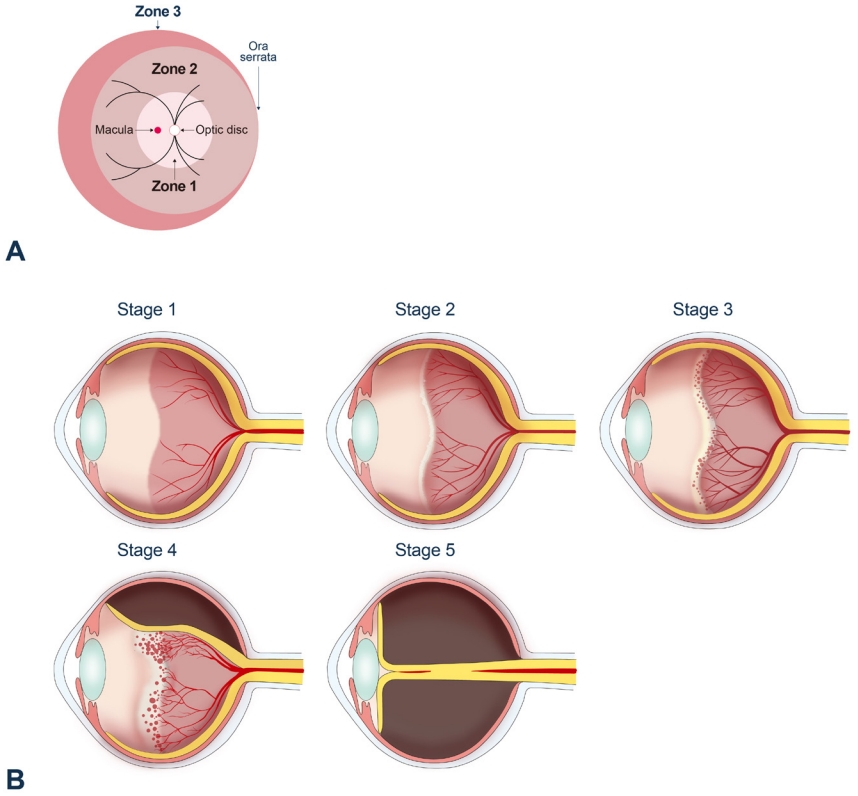
There have been global tri-phasic epidemic periods of retinopathy of prematurity (ROP). In recent years, its incidence has reportedly been 10%–40% depending on country and study population. Current treatment strategies for ROP include laser photocoagulation, surgical treatment, and anti-vascular endothelial growth factor treatment, the role of which has drawn attention in recent years.
- Growth patterns of preterm infants in Korea
- Joohee Lim, So Jin Yoon, Soon Min Lee
- Clin Exp Pediatr. 2022;65(1):1-9. Published online July 8, 2021
-
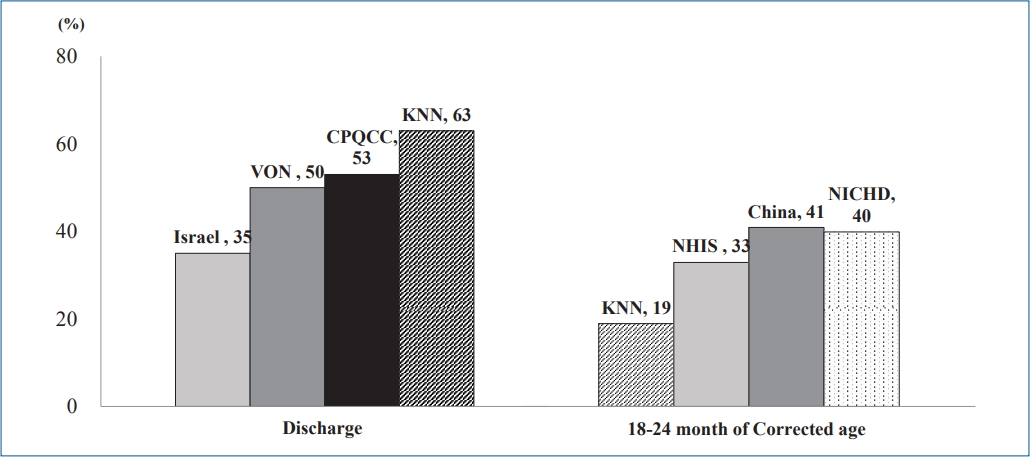
∙ The growth of preterm infants is a main focus of neonatology.
∙ Preterm infants in Korea, especially those with a very low birth weight, achieve retarded growth.
∙ Careful growth monitoring and early intervention will contribute to better development outcomes and quality of life for preterm infants and improve public health.
- Nutrition
- Changes in health status of North Korean children and emerging health challenges of North Korean refugee children
- Seong-Woo Choi
- Clin Exp Pediatr. 2021;64(11):552-558. Published online May 17, 2021
-
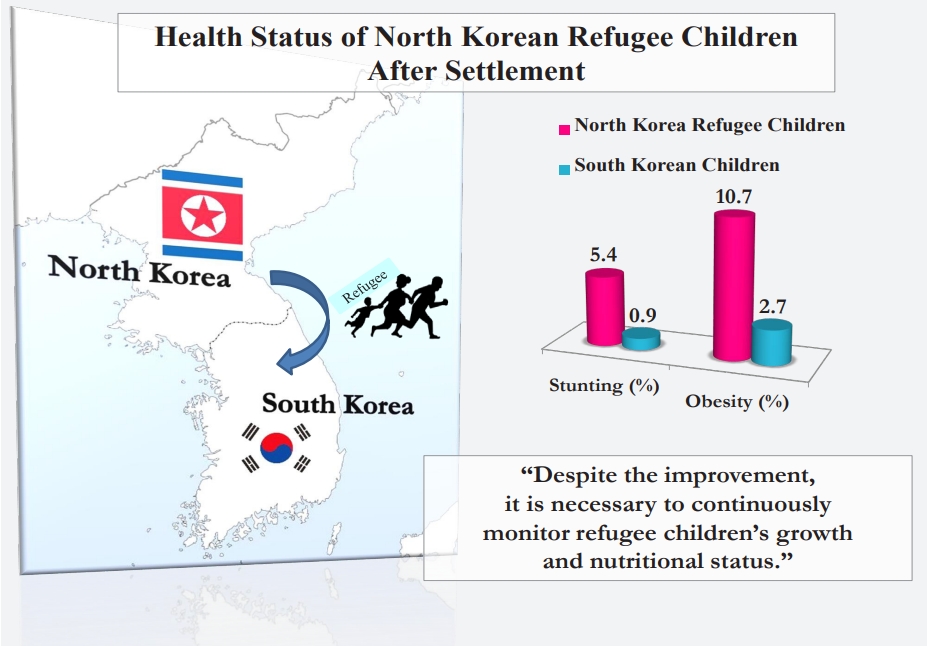
· Among North Korean refugee (NKR) children under 5 years, 61% and 9.3% were underweight in 1998 and 2017, respectively.
· The immunization rate of NKR children exceeded 90% since 2006.
· For NKR children, protein-energy malnutrition was the #1 cause of death in 2009 versus #17 in 2019.
· In 2020, stunting affected 5.4% and 0.9% and obesity affected 10.7% and 2.7% of NKR versus South Korean children, respectively.
- Original Article
- General Pediatrics
- Effect of maternal and child factors on stunting: partial least squares structural equation modeling
- Agus Santosa, Essa Novanda Arif, Dinal Abdul Ghoni
- Clin Exp Pediatr. 2022;65(2):90-97. Published online May 4, 2021
-
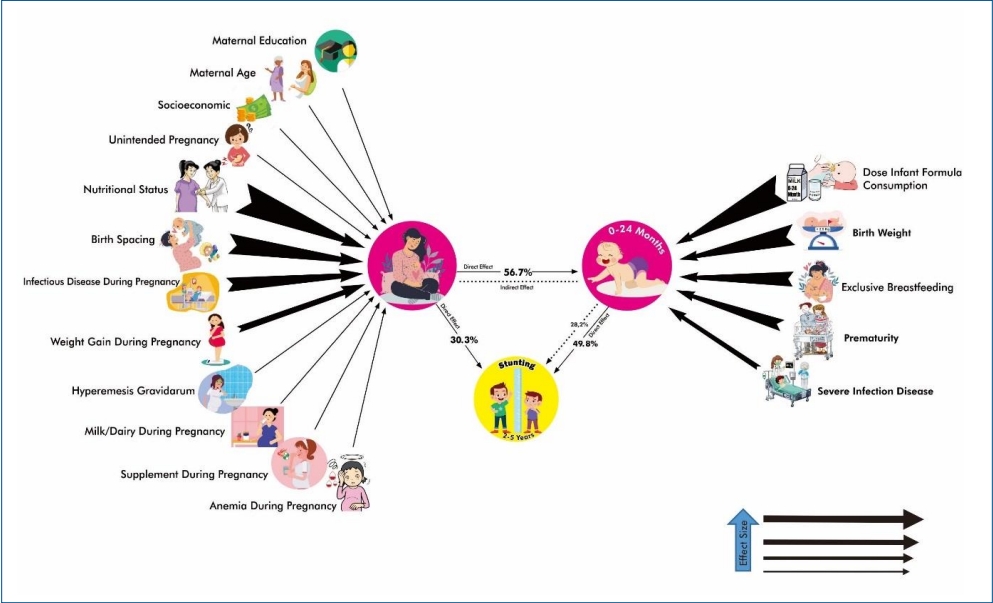
Question: What effects do maternal and child factors have on stunting? Are there significant indicators of stunting?
Finding: Child and maternal factors had 49.8% and 30.3% effects on stunting, respectively. The primary child factor was infant formula dose, while the primary maternal factor was nutritional status.
Meaning: More attention to nutritional status during pregnancy and ensuring the appropriate dose of infant formula at ages 6–24 months can prevent stunting.
- Neonatology (Perinatology)
- The relation between serum levels of epidermal growth factor and necrotizing enterocolitis in preterm neonates
- Heba Mostafa Ahmed, Nsreen Mostafa Kamel
- Clin Exp Pediatr. 2019;62(8):307-311. Published online March 15, 2019
-
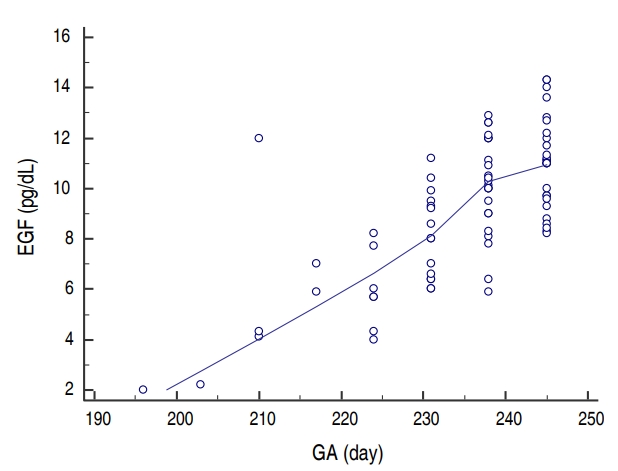
Purpose: Necrotizing enterocolitis (NEC) is one of the most serious complications of prematurity. Many risk factors can contribute to the development of NEC. The epidermal growth factor (EGF) plays a major role in intestinal barrier function, increases intestinal enzyme activity, and improves nutrient transport. The aim of this study was to assess the role of epidermal growth factor in the...
- Endocrinology
- Comparison of effectiveness of growth hormone therapy according to disease-causing genes in children with Noonan syndrome
- Kyo Jin Jo, Yoo Mi Kim, Ju Young Yoon, Yeoun Joo Lee, Young Mi Han, Han-Wook Yoo, Hyang-Sook Kim, Chong Kun Cheon
- Clin Exp Pediatr. 2019;62(7):274-280. Published online December 3, 2018
-
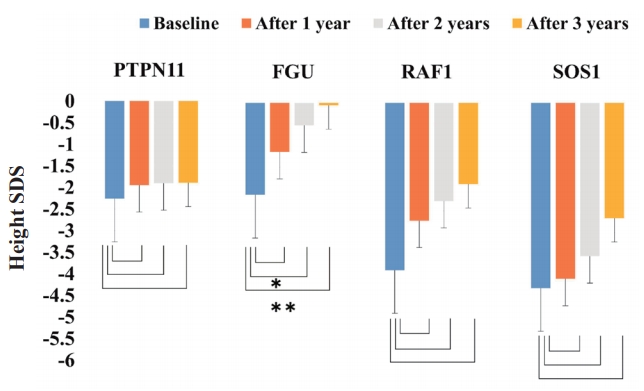
Purpose: To analyze the growth response to growth hormone (GH) therapy in prepubertal patients with Noonan syndrome (NS) harboring different genetic mutations. Methods: Twenty-three patients with prepubertal NS treated at Pusan National University Children’s Hospital between March 2009 and July 2017 were enrolled. According to the disease-causing genes identified, the patients with NS were divided into 4 groups. Three groups were...
- Changes of the growth plate in children: 3-dimensional magnetic resonance imaging analysis
- Hyung Ho Yun, Hyun-Jung Kim, Min-Sun Jeong, Yun-Sun Choi, Ji-Young Seo
- Clin Exp Pediatr. 2018;61(7):226-230. Published online July 15, 2018
-
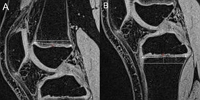
Purpose: This pilot study assessed changes in the growth plate and growth rates in children during a 6-month period. Methods: The study included 31 healthy children (17 boys, 14 girls) under evaluation for growth retardation. Height, weight, bone age, insulin like growth factor-1 (IGF-1), and insulin like growth factor binding protein 3 (IGF-BP3) were measured at baseline and after 6 months....
- Review Article
- General Pediatrics
- The 2017 Korean National Growth Charts for children and adolescents: development, improvement, and prospects
- Jae Hyun Kim, Sungha Yun, Seung-sik Hwang, Jung Ok Shim, Hyun Wook Chae, Yeoun Joo Lee, Ji Hyuk Lee, Soon Chul Kim, Dohee Lim, Sei Won Yang, Kyungwon Oh, Jin Soo Moon; for the Committee for the Development of Growth Standards for Korean Children and Adolescents, the Committee for School Health and Public Health Statistics; the Committee for School Health and Public Health Statistics; the Korean Pediatric Society, and Division of Health and Nutrition Survey; Korea Centers for Disease Control and Prevention
- Clin Exp Pediatr. 2018;61(5):135-149. Published online May 28, 2018
-

Growth charts are curves or tables that facilitate the visualization of anthropometric parameters, and are widely used as an important indicator when evaluating the growth status of children and adolescents. The latest version of the Korean National Growth Charts released in 2007 has raised concerns regarding the inclusion of data from both breastfed and formula-fed infants, higher body mass index...
- Original Article
- Neonatology (Perinatology)
- TORCH (toxoplasmosis, rubella, cytomegalovirus, and herpes simplex virus) screening of small for gestational age and intrauterine growth restricted neonates: efficacy study in a single institute in Korea
- Mi Hae Chung, Chan Ok Shin, Juyoung Lee
- Clin Exp Pediatr. 2018;61(4):114-120. Published online April 23, 2018
-
Purpose Routine screening for toxoplasmosis, rubella, cytomegalovirus (CMV), and herpes simplex virus (TORCH) in intrauterine growth restriction (IUGR) and small for gestational age (SGA) neonates has become a common practice. However, the incidence of TORCH varies across countries, and the cost of TORCH testing may be disadvantageous compared to disease-specific screening. To evaluate the efficacy of TORCH screening, the medical charts...
- Developmental and Behavioral Medicine
- Usefulness of the Korean Developmental Screening Test for infants and children for the evaluation of developmental delay in Korean infants and children: a single-center study
- Chung-Hyuk Yim, Gun-Ha Kim, Baik-Lin Eun
- Clin Exp Pediatr. 2017;60(10):312-319. Published online October 20, 2017
-

Purpose To evaluate the usefulness of the Korean Developmental Screening Test (K-DST) for infants and children for developmental delay assessment.
Methods This study was based on retrospective studies of the results of the K-DST, Preschool Receptive-Expressive Language Scale (PRES), Sequenced Language Scale for Infants (SELSI), Childhood Autism Rating Scale (CARS), Modified Checklist for Autism in Toddlers (M-CHAT), electroencephalography, magnetic resonance imaging, and extensive...
- Case Report
- Endocrinology
- Concomitant occurrence of Turner syndrome and growth hormone deficiency
- Jung Yu, Ha Young Shin, Chong Guk Lee, Jae Hyun Kim
- Clin Exp Pediatr. 2016;59(Suppl 1):S121-S124. Published online November 30, 2016
-
Turner syndrome (TS) is a genetic disorder in phenotypic females that has characteristic physical features and presents as partial or complete absence of the second sex chromosome. Growth hormone deficiency (GHD) is a condition caused by insufficient release of growth hormone from the pituitary gland. The concomitant occurrence of TS and GHD is rare and has not yet been reported...
- Original Article
- Neonatology (Perinatology)
- Modification of nutrition strategy for improvement of postnatal growth in very low birth weight infants
- Ah Young Choi, Yong Wook Lee, Mea-young Chang
- Clin Exp Pediatr. 2016;59(4):165-173. Published online April 30, 2016
-
Purpose To identify the effects of modified parenteral nutrition (PN) and enteral nutrition (EN) regimens on the growth of very low birth weight (VLBW) infants.
Methods The study included VLBW infants weighing <1,500 g, admitted to Chungnam National University Hospital between October 2010 and April 2014, who were alive at the time of discharge. Subjects were divided according to 3 periods: period 1...
- Nephrology (Genitourinary)
- Impaired angiogenesis in the enalapril-treated neonatal rat kidney
- Hyung Eun Yim, Kee Hwan Yoo, Eun Soo Bae, Young Sook Hong, Joo Won Lee
- Clin Exp Pediatr. 2016;59(1):8-15. Published online January 22, 2016
-
Purpose Nephrogenesis is normally accompanied by a tightly regulated and efficient vascularization. We investigated the effect of angiotensin II inhibition on angiogenesis in the developing rat kidney.
Methods Newborn rat pups were treated with enalapril (30 mg/kg/day) or vehicle (control) for 7 days after birth. Renal histological changes were checked using Hematoxylin & Eosin staining. We also investigated the intrarenal expression of vascular...
- Case Report
- Hypopituitarism and Legg-Calve-Perthes disease related to difficult delivery
- Veysel Nijat Baş, Salih Uytun, Ümit Erkan Vurdem, Yasemin Altuner Torun
- Clin Exp Pediatr. 2015;58(7):270-273. Published online July 22, 2015
-
Legg-Calve-Perthes (LCP) disease is characterized by idiopathic avascular osteonecrosis of the epiphysis of the femur head. The main factor that plays a role in the etiology of the disease is decreased blood flow to the epiphysis. Many predisposing factors have been suggested in the etiology of LCP disease, and most have varying degrees of effects. Here we present the case...
- Review Article
- Nutritional strategy of early amino acid administration in very low birth weight infants
- Byong Sop Lee
- Clin Exp Pediatr. 2015;58(3):77-83. Published online March 20, 2015
-
Relative to a fetus of the same gestational age, very low birth weight (VLBW) infants are more likely to be underfed and to undergo growth restriction during their early hospital stay. The current trend towards "early and aggressive" nutritional strategies in VLBW infants aims to overcome the early nutritional deficiency and thereby boost postnatal catch-up growth, simultaneously improving long-term neurodevelopmental...
- Growth hormone treatment and risk of malignancy
- Hyun-Wook Chae, Duk-Hee Kim, Ho-Seong Kim
- Clin Exp Pediatr. 2015;58(2):41-46. Published online February 28, 2015
-
Growth hormone (GH) treatment has been increasingly widely used for children with GH deficiencies as the survival rate of pediatric patients with malignancies has increased. Both GH and insulin-like growth factor-I have mitogenic and antiapoptotic activity, prompting concern that GH treatment may be associated with tumor development. In this review, the authors examined the relationship between GH treatment and cancer...
- Efficacy and safety of growth hormone treatment for children born small for gestational age
- Il Tae Hwang
- Clin Exp Pediatr. 2014;57(9):379-383. Published online September 30, 2014
-
Recombinant growth hormone (GH) is an effective treatment for short children who are born small for gestational age (SGA). Short children born SGA who fail to demonstrate catch-up growth by 2-4 years of age are candidates for GH treatment initiated to achieve catch-up growth to a normal height in early childhood, maintain a normal height gain throughout childhood, and achieve...
- Original Article
- Prader-Willi syndrome: a single center's experience in Korea
- Yea Ji Kim, Chong Kun Cheon
- Clin Exp Pediatr. 2014;57(7):310-316. Published online July 23, 2014
-
Purpose Prader-Willi syndrome (PWS) is a complex genetic disorder that results from the lack of paternally expressed genes in the chromosome 15q11-q13 region. This study was performed to delineate the clinical features of PWS infants and toddlers and the effects of two-year growth hormone (GH) treatment according to gender and age at the start of treatment.
Methods The clinical characteristics and the results...
- Case Report
- A chromosome 1q44 deletion in a 4-month-old girl; The first report in Korea
- Joo Hyun Cho, Eun Song Song, Hee Na Kim, Burm Seok Oh, Young Youn Choi
- Clin Exp Pediatr. 2014;57(6):292-296. Published online June 30, 2014
-
The deletion of the distal long arm of chromosome 1 is associated with a characteristic facial appearance and a pattern of associated malformations. Characteristic manifestations include a round face with prominent 'cupid's bow' and downturned corners of the mouth, thin vermilion borders of lips, a long upper lip with a smooth philtrum, a short and broad nose, epicanthal folds, apparently...
- Original Article
- Clinical features of macrocephaly at birth in Korea
- Goun Jeong, Minkyun Kim, Byoung Hee Han
- Clin Exp Pediatr. 2014;57(2):75-78. Published online February 24, 2014
-
Purpose This study aimed to investigate the clinical features of macrocephaly at birth in Korea using ultrasonography.
Methods We retrospectively investigated the medical records of full-term birth neonates in Cheil General Hospital & Women's Healthcare Center from January 2000 to June 2012. The following parameters were recorded and analyzed: gestational age, sex, birth weight, height, occipitofrontal circumference (OFC), physical examination, perinatal problems, and...
- Expression of peroxisome proliferator-activated receptor (PPAR)-α and PPAR-γ in the lung tissue of obese mice and the effect of rosiglitazone on proinflammatory cytokine expressions in the lung tissue
- Seung Lok Ryu, Jae Won Shim, Duk Soo Kim, Hye Lim Jung, Moon Soo Park, Soo-Hee Park, Jinmi Lee, Won-Young Lee, Jung Yeon Shim
- Clin Exp Pediatr. 2013;56(4):151-158. Published online April 22, 2013
-
Purpose We investigated the mRNA levels of peroxisome proliferator-activated receptor (PPAR)-α, PPAR-γ, adipokines, and cytokines in the lung tissue of lean and obese mice with and without ovalbumin (OVA) challenge, and the effect of rosiglitazone, a PPAR-γ agonist.
Methods We developed 6 mice models: OVA-challenged lean mice with and without rosiglitazone; obese mice with and without rosiglitazone; and OVA-challenged obese mice with and...
- Early neurodevelopment in very low birth weight infants with mild intraventricular hemorrhage or those without intraventricular hemorrhage
- Il Rak Choi, Jang Hoon Lee, Moon Sung Park, Ji Yeon Kim, Kyu Hee Park, Gun-Ha Kim, So-Hee Eun
- Clin Exp Pediatr. 2012;55(11):414-419. Published online November 23, 2012
-
Purpose This study aimed to assess early development in very low birth weight (VLBW) infants with mild intraventricular hemorrhage (IVH) or those without IVH and to identify the perinatal morbidities affecting early neurodevelopmental outcome.
Methods Bayley Scales of Infant Development-II was used for assessing neurological development in 49 infants with a birth weight <1,500 g and with low grade IVH (≤grade II) or...
- Review Article
- Endocrine problems in children with Prader-Willi syndrome: special review on associated genetic aspects and early growth hormone treatment
- Dong-Kyu Jin
- Clin Exp Pediatr. 2012;55(7):224-231. Published online July 17, 2012
-
Prader-Willi syndrome (PWS) is a complex multisystem genetic disorder characterized by hypothalamic-pituitary dysfunction. The main clinical features include neonatal hypotonia, distinctive facial features, overall developmental delay, and poor growth in infancy, followed by overeating with severe obesity, short stature, and hypogonadism later in development. This paper reviews recent updates regarding the genetic aspects of this disorder. Three mechanisms (paternal deletion,...
- Original Article
- Transforming growth factor beta receptor II polymorphisms are associated with Kawasaki disease
- Yu Mi Choi, Kye Sik Shim, Kyung Lim Yoon, Mi Young Han, Sung Ho Cha, Su Kang Kim, Joo Ho Jung
- Clin Exp Pediatr. 2012;55(1):18-23. Published online January 31, 2012
-
Purpose Transforming growth factor beta receptor 2 (
TGFBR2 ) is a tumor suppressor gene that plays a role in the differentiation of striated cells and remodeling of coronary arteries. Single nucleotide polymorphisms (SNPs) of this gene are associated with Marfan syndrome and sudden death in patients with coronary artery disease. Cardiovascular remodeling and T cell activation ofTGFBR2 gene suggest that the...
- Review Article
- Systematic review of the clinical and genetic aspects of Prader-Willi syndrome
- Dong Kyu Jin
- Clin Exp Pediatr. 2011;54(2):55-63. Published online February 28, 2011
-
Prader-Willi syndrome (PWS) is a complex multisystem genetic disorder that is caused by the lack of expression of paternally inherited imprinted genes on chromosome 15q11-q13. This syndrome has a characteristic phenotype including severe neonatal hypotonia, early-onset hyperphagia, development of morbid obesity, short stature, hypogonadism, learning disabilities, behavioral problems, and psychiatric problems. PWS is an example of a genetic condition caused...
-

-
-
8.02023CiteScore94th percentilePowered by
-
Impact Factor3.2
-
- TOPICS
- ARTICLE CATEGORY
- Editorial Office
-
Korean Pediatric Society
#1606 Seocho World Officetel, 19 Seoun-ro, Seocho-ku, Seoul 06732, Korea
Tel: +82-2-3473-7306 Fax: +82-2-3473-7307 E-mail: office@e-cep.org
Clinical and Experimental Pediatrics is an open access journal. All articles are distributed under the terms of the Creative Commons Attribution NonCommercial License (http://creativecommons.org/licenses/by-nc/4.0/)
Copyright © 2025 by Korean Pediatric Society.











